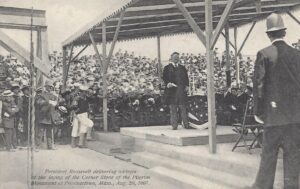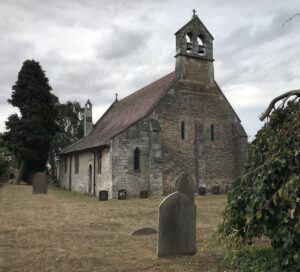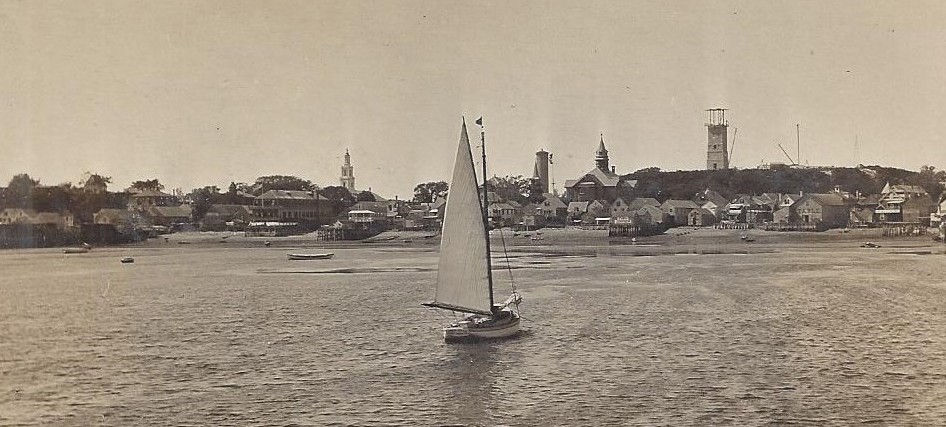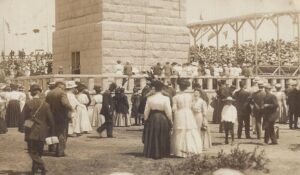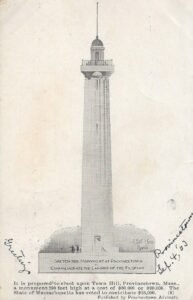 One of the earliest designs for the Pilgrim Monument. Unless otherwise noted, all images courtesy Salvador Vasques, My Provincetown Memorabilia Collection
One of the earliest designs for the Pilgrim Monument. Unless otherwise noted, all images courtesy Salvador Vasques, My Provincetown Memorabilia Collection
Fifteen years after the second effort to build a monument in Provincetown had been abandoned and three years after Plymouth dedicated its National Monument to the Forefathers, there was another initiative to commemorate the First Landing of the Pilgrims at Provincetown. On 29 February 1892, a group of civic-minded citizens – James H. Hopkins, James Gifford, Artemas P. Hannum, Moses N. Gifford, Howard F. Hopkins, Joseph H. Dyer, and their associates and successors – were made a corporation, the Cape Cod Pilgrim Memorial Association (CCPMA), by an act of the Massachusetts Legislature. Later that year an appeal for funds was circulated to the general public and a request for funding was made to the Massachusetts Legislature. Not only did CCPMA members see their mission as building an appropriate monument to commemorate the arrival of the Mayflower at Provincetown, they were determined, too, to recognize other significant events in Provincetown’s Pilgrim history, including the Signing of the Mayflower Compact, the birth of Peregrine White, and the death of Dorothy May Bradford.
Though progress toward a Pilgrim Monument atop High Pole Hill was slow, there was enough steady progress over the next few years to convince the public that the auspicious start would, this time, reach a grand finale. In July 1896, a granite and bronze tablet commemorating the Signing of the Compact was unveiled and dedicated in Provincetown, paid for with state and CCPMA funds. In October 1897, a conference was convened at Provincetown’s Pilgrim House in response to a call “urging a new move designed to initiate measures for the emphatic assertion of Provincetown’s historical claims.”
Included in the proposal to lay the cornerstone of a Pilgrim Monument was a plan to include a fire- and burglar-proof vault to house the Bradford manuscript, Of Plimoth Plantation, returned that May to Massachusetts from England and of which, it seems, Provincetown hoped to take possession. A 21 February 1898 story in the Boston Globe resurrected the agitation felt by the citizens of Cape Cod at being deprived of their share of the glory, and made note of the fact that during exercises the previous year to receive the Bradford manuscript, no Cape Cod society had been invited and no mention had been made that Dorothy May Bradford had drowned while the Mayflower was anchored in Provincetown Harbor.[1]
In July 1901 the Boston Journal, reporting on a meeting of the Pilgrim Club at Brewster, noted that the “subject of building the monument has been in agitation for some time, until J. Henry Sears and Roland Nickerson sent out invitations to the Cape people to come together and perfect plans for the fitting observance of the anniversary of the landing of the Pilgrims and the signing of the compact on the Mayflower. This monument is intended to be the consummation of plans formed some time ago at Provincetown.”
An indefatigable promoter of the Pilgrim Monument, Captain Joseph Henry “J. Henry” Sears (1830-1912) – Master Mariner and ships’ agent – oversaw the merger of the Pilgrim Club with the CCPMA, thus injecting the formal organization with new energy and purpose. The people of Provincetown, meanwhile, voted to convey the deed for High Pole Hill to the CCPMA, insuring that when the time came to build, the site would be ready.
“Provincetown scoffs and laughs at Plymouth Rock. It comes after the landing in Cape Cod, and they are about to accent the fact by erecting an elaborate monument..."
In July 1902, the New York Daily Tribune stoked the “civil war” by reporting that “Provincetown scoffs and laughs at Plymouth Rock. It comes after the landing in Cape Cod, and they are about to accent the fact by erecting an elaborate monument, by a strange system of money raising, as will appear further on.” The story went on to discuss that private subscriptions were being received by the Cape Cod Pilgrim Memorial Association at a little store in Provincetown and that “any person of good character who pays into the treasury not less than $1 may become a life member.”[2]
By May of 1903, the CCPMA was actively engaged in raising funds to build the monument, having previously secured a $25,000 commitment from the Commonwealth of Massachusetts contingent upon the CCPMA raising an equal amount. By early 1904, subscriptions from individuals, towns, schoolchildren, and patriotic societies were mounting up quickly, and with a $500 contribution from the Town of Wellfleet the monument fund met its goal, thus securing the matching state contribution.[3]
In June 1906, an appropriation for $40,000 – that had been conditioned, when first introduced, on the Commonwealth raising an equal amount – was passed by the United States Congress.[4] One newspaper noted that there is “joy in Provincetown over the fact that the Pilgrim Monument there is assured.” All that remained was a suitable design.
With more than $90,000 in hand, in September 1906 the CCPMA opened a competition for designs, offering five prizes of $200 each, the drawings to be sent by October 1 to Willard T. Sears (1837-1920), the prominent New England architect.[5] In late January 1907, the winning design, selected from more than 150 submissions, was revealed to be a virtual copy of the Torre del Mangia at Siena in Italy.
Architects were flummoxed by the choice, one commenting in the Boston Globe, “If all they want is an architectural curiosity, why not select the Leaning Tower of Pisa and be done with it. That would attract more attention down on Cape Cod than the Tower del Mangia of Siena which, by the way, has always been regarded as a bit of civic architecture, although it is undoubtedly a very beautiful tower. It doesn’t look at all out of place, for instance, as a feature of the central fire station which Wheelwright designed for Boston.[6] But here again it has a civic purpose, and a good one. I question its propriety, however, as a memorial to the Pilgrim fathers.”[7]
On Tuesday, 20 August 1907, the cornerstone of the Pilgrim Monument was laid in a Masonic ceremony attended by President Theodore Roosevelt, who arrived in Provincetown Harbor on the presidential yacht, Mayflower, accompanied by eight battleships. He began his address by noting that “It is not too much to say that the event commemorated by the monument which we have come here to dedicate was one of those rare events which can in good faith be called of world importance. The coming hither of the Puritans three centuries ago shaped the destinies of this continent, and therefore profoundly affected the destiny of the whole world.”[8]
That moment, at noon, was not only a proud, momentous, and historic day for the Cape Cod fishing village – by then with a substantial Portuguese immigrant population – but also the tangible manifestation of an idea that had dared to be imagined more than half a century earlier. Weeks before the laying of the cornerstone, in preparing High Pole Hill for the monument’s cement foundation, fragments of the white marble tablet that had adorned the entrance of the old Town House were unearthed, a sign, perhaps, that the dream of 1853 had indeed come full circle.
A copper box, set into a cavity in the cornerstone, contained a time capsule of documents – speeches, town reports, bylaws, souvenir booklets, and a list of contributors – mementos from the present for the future. Copies of the Bible, the Mayflower Compact, and Bradford’s Of Plimoth Plantation – contributed by the Commonwealth of Massachusetts, which retained ownership of the original manuscript – were also placed in the box, bridging the present with the past. The Old World and the previous lives that the Pilgrims had left behind were also memorialized with historic stones, incorporated into the Monument, one cut from the ancient church at Austerfield where William Bradford was baptized, another from the church in Leiden where the Pilgrims worshipped, and paving stones from the ancient quay at Delfshaven from where, on 1 August 1620, the Pilgrims departed for England on the Speedwell.[9]
On another August day, 5 August 1910, three years after the laying of the cornerstone and after what one newspaper wrote was “eighteen years of toil and effort, battling with disappointment, lethargy and indifference, of surmounting the insurmountable and now and again snatching back the project from the very jaws of defeat,” the completed Pilgrim Monument was dedicated in the presence of President William Howard Taft, who, as Secretary of War three years earlier, had been a member of the commission – along with Massachusetts Governor Curtis Guild, Jr., and CCPMA President J. Henry Sears – overseeing the project.
Today, one cannot imagine the iconic Pilgrim Monument being anything but what it is. Its 252 feet of New England granite perched atop a 100-foot sand dune lives up to what CCPMA members envisioned in a 1904 fundraising pamphlet, wherein an item from Harper’s Weekly was reprinted: “It is a quaint old town, much the same now as it was 50 years ago, with the same domelike hill in its center. The monument will stand on this hill, and run straight and plain into the sky, so that any ship coming or going will catch sight of it long before land can be seen. The plan is a good one. Such markings of our early beginnings are of value, because through all the ages the reminders of great deeds, noble men and epoch-making ideas have served to furnish stimulus and example to those that come after.”
Notes
[1] The disappearance and rediscovery of the Bradford manuscript is well documented. The Massachusetts State Library now has custody of the original.
[2] In his 1911 book, The Pilgrims and Their Monument, Edmund J. Carpenter lists the names of more than three thousand subscribers.
[3] Plymouth donated the handsome sum of $2,000 to the project.
[4] There was a contingency that the monument be used as an observation tower during wartime.
[5] Willard T. Sears became the consulting architect for the monument project.
[6] The fire tower was built in 1892 by Edmund March Wheelwright, who served as architect of Boston. The building now houses the Pine Street Inn homeless shelter.
[7] The Pilgrim Monument also bears a resemblance to Boston’s Old South Church (1873), designed by Willard T. Sears.
[8] The Roosevelt address can be found at: theodorerooseveltcenter.org.
[9] The historic stone from Austerfield arrived in Boston from Liverpool aboard a Cunard steamship in June 1905. Cunard assumed all the costs of transporting the stone, as did the teamsters who delivered the stone from Boston to Provincetown. While awaiting construction of the Monument, the stone was displayed in a store window in Provincetown, where it was an object of intense interest to tourists.
Share this:

About Amy Whorf McGuiggan
Amy Whorf McGuiggan recently published Finding Emma: My Search For the Family My Grandfather Never Knew; she is also the author of My Provincetown: Memories of a Cape Cod Childhood; Christmas in New England; and Take Me Out to the Ball Game: The Story of the Sensational Baseball Song. Past projects have included curating, researching, and writing the exhibition Forgotten Port: Provincetown’s Whaling Heritage (for the Pilgrim Monument and Provincetown Museum) and Albert Edel: Moments in Time, Pictures of Place (for the Provincetown Art Association and Museum).View all posts by Amy Whorf McGuiggan →
